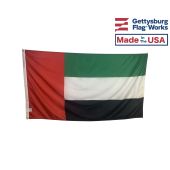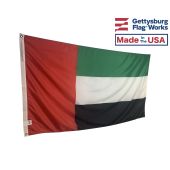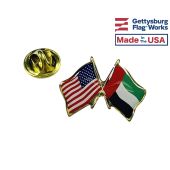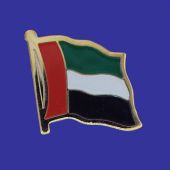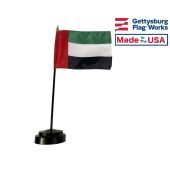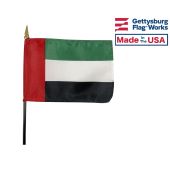United Arab Emirates Flags
Flag of the United Arab Emirates
The flag of the United Arab Emirates has a great deal in common with the flags of its members due to the shared history that those nations share, but the design of the United Arab Emirates flag is still distinct enough that it can be distinguished from the other flags of the Middle East. The United Arab Emirates flag is dominated by the colors of the Pan-Arab movement, which is particularly appropriate because it is a union of many distinct monarchies rather than a single nation.
- Capital of United Arab Emirates: Abu Dhabi
- Area of United Arab Emirates: 82,880 sq. km
- Languages used in United Arab Emirates: Arabic, Persian, English, Hindi, Urdu
- Religions in United Arab Emirates: Muslim, Christian, Hindu
Colors and Symbolism of the United Arab Emirates Flag
The flag of the United Arab Emirates is made up of three horizontal stripes of green, white, and black that stretch out from a vertical stripe of red that is arranged along the flag's hoist. The red stripe represents energy and the sacrifices made by the people for their nation, the green stands for growth and prosperity, the black stands for dignity, and the white stripe represents peace and purity. The colors of the United Arab Emirates flag are also the colors of the Pan-Arab movement, which gives them additional meaning that relates to the history of the Middle East. The black stripe represents the Prophet Muhammad and the Rashidun Caliphate, the green stripe represents the Fatimid Caliphate, the white stripe stands for the Ummayad Caliphate, and the red stripe represents the Khawarij movement.
History of the United Arab Emirates Flag
The flag of the United Arab Emirates is relatively young due to the youth of the organization itself, but many of the constituent emirates have flags of their own that are significantly older. Most of these flags have solid red fields, a trait that they share with most historical flags in the Middle East. Those red fields are combined with emblems, text, or stripes in order to create unique flags for each individual emirate. Most of those details are white, which is also due to the vexilloligical traditions of the region. The modern flag that represents the entirety of the United Arab Emirates was designed by Abdullah Mohammad Al Maainah to meet the needs of the union when it formed, and it first flew over the United Arab Emirates in 1971. The design proved to popular with the people of the United Arab Emirates, so it has never been changed.
